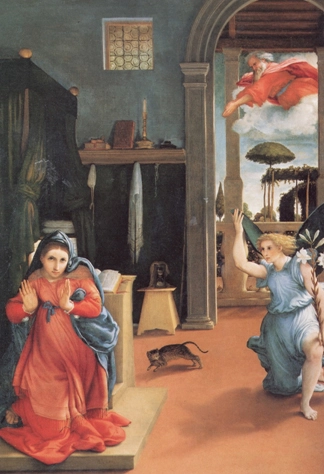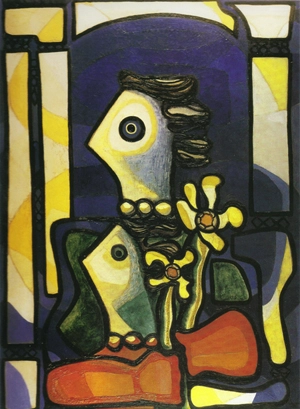ARAS Connections: Image and Archetype - 2018 Issue 3

This edition of ARAS Connections features two remarkable papers that were originally presented at the fourth Art and Psyche Conference held in Sicily in 2015. It is important to start by acknowledging how wonderfully productive the collaboration between Art and Psyche and ARAS has become. Art and Psyche reaches out into the community of those interested in the relationship between archetypal energies, symbol formation, and creative processes. And ARAS provides a digital container for sharing the original researches that emerge out of the Art and Psyche conferences. This is perfectly realized in these two papers, one of which is about revelation and the other is about evolution.
Irene Cioffi Whitfield’s riveting description of Lotto’s Annunciation of 1553 is written with such depth of feeling and intimate knowledge of archetypal processes that it leaves the reader in awe and wonder of Whitfield’s gifts, in much the same way that Whitfield herself approaches Lotto and his painting. Among its other fine qualities, this paper is beautifully written as the reader/viewer is led through the delicate portals of appreciating and understanding the multiple levels of interaction and meaning in the painting. Her paper distills the density of meaning in a moment of revelation:
"There is no calm, only emotional agitation. Despite her discomfort and upset, Mary’s receptivity in the face of this divine commotion is absolute: “Behold the handmaiden of the Lord; be it done to me according to thy word” (Luke: 27-38). Like Persephone, the Virgin is raped and penetrated by a divine spirit and in accepting this fertilization she welcomes both life and death into her inexorably altered world. We can see by the way she looks outwardly, that she expects no less from us, the viewers of the divine incarnation. But are we up to it?”
If Whitfield’s paper focuses on a moment of apocalyptic revelation, Joan Golden-Alexis takes us on a very different journey in her exploration of the life’s work of the Cuban artist, Amelia Paláez (1896-1968). This is a journey of evolution not revelation, of the slow unfolding of an individuation process over a lifetime of painting. Sometimes the word “individuation” gets overused and becomes a bit of a Jungian cliche. But, Golden-Alexis shows us how best to use the term “individuation” in describing a lifetime of slow differentiation, of the emergence of a human being with a “Self” that is part of but also separate from her secure, containing, privileged environment. As Golden-Alexis states it:
"The images reveal a slow movement toward identity, individuation, agency, a process that appears to take place against the grain of something innate, against the gravitational pull of all that offers comfort and safety and which supports a kind of undifferentiated diffuseness of Self and other.”
Welcome to this wonderfully rich edition of ARAS Connections.
Tom Singer
Apocalypse Now: A Psychology of Conception in Lorenzo Lotto’s Annunciation of 1535

Judged by conventional iconography Lorenzo Lotto's Annunciation of 1535 is uncanny, uncomfortable and strangely at odds with typical representations of this seminal subject (Fig. 1). However if "read" like a dream it carries its own insights into an archetypal realm where the son of God is incarnated in a young virgin who becomes a mother. Her son is divine and human. The conception is divine and human. The Annunciation is a paradox that Jung described as a moment of synchronicity -- when eternal and serial time intersect and meaning is born. As the Christian myth tells us, this announcement and conception of the divine, which we could also describe psychologically as the manifestation of the Self, can only materialize in the human individual and it carries an enormous potential for imagination and creativity. Along with many others, Lotto's painting tells us that virginity is a vital precondition for conception to occur, but uniquely, he relates a sense of emotional tension and conflict, along with a highly enigmatic quality of that feminine virgin state, which is both the vessel of creativity and the medium of its inception into the material world of human consciousness.
A dictionary definition of the verb, to announce, tells us that its roots stem from the Latin annuntiare which combines two stems: ad nuntiare meaning to report and nuntius, the messenger. A reporting which includes a messenger. Along with “to proclaim and make known publicly,” the verb also means “to indicate beforehand, foretell”. In Lorenzo Lotto's painting, as in all others of the same subject the announcement of a divine conception is delivered by the Angel Gabriel to the young Virgin Mary. Conceive, from the Latin concepire is to take in, to cause to begin, to originate. Other meanings link the word to image, imagination and apprehension. Apprehend means to “arrest and seize” as well as “to perceive and understand meaning”. The heightened affect of Lotto's young Virgin who has been chosen to serve as the mother of Jesus suggests many things at once -- visceral fear, sudden seizure, foreboding insight, the uncomfortable border between life and death. These are all present at the moment of incarnation.
Amelia: Images of Mystery—the Transformation of Shadow in Women

Then I learned that he who fights against the night must move its deepest darkness so that it gives out its light—Walter Benjamin
Introduction
During my years as a clinician, I have always held shadow—that point of darkness—as the place to begin my inquiry, and the place to begin drawing my patients and myself into a wider consciousness. It is shadow, where I look to have my questions, not answered, but constantly refined. In these queries I have noticed a difference in the way shadow, one’s dark shadow as well as one’s bright shadow—one’s unlived life potential—is expressed in women and in men. There are differences in the kinds of images presented, the arc of the transformation in these images over time, and particularly the narrative, the discourse that each gender conveys. The narratives of women have particularly captured my interest, and are the focus of this exploration.
Amelia’s Journey Through Shadow
In this exploration, I will be looking into the work of the Cuban artist, Amelia Paláez (1896-1968). Amelia has produced a series of paintings that give us an intimate view into her journey through shadow towards an authentic expression of Self. Her imagery is interesting in that it displays movement from a powerful psychic ground that is internal, closed off and incubating to one that unfolds with uncommon strength and velocity. Following her imagery, I will attempt to bring forth the compelling value and meaning of her work in making shadow in women more accessible to our understanding.
Her paintings will be presented in chronological order, enabling them to describe the trajectory of her imagery. The discussion is divided into four parts: The Introduction of the Vessel; the Re-introduction of the Human Element; and the Impact of Volumetric Space on the artist’s work. I will conclude with a short discussion of how these images may impact, and inform the theory of women’s journey of integration.
Read Amelia: Images of Mystery—the Transformation of Shadow in Women in its entirety here.
The Poetry Portal

In the following piece, poet, teacher and activist Iemanjá Brown feels for the life-death cycles of objects made an unmade by human animals. This is a meditation on the symbol of SEED, part of our ongoing ekphrastic writing series. A reading and performance night dedicated to SEED will be held on October 9th, marking the 7th installment of Ekphrazein.
Painted on a Mimbres bowl from circa 1050CE, this figure has been identified by archeologists as Kokopelli, the flute player whose humpback is filled with seeds. Though the Mimbres branch of the Mogollon were identified by anthropologists as disappeared entirely after 1450, it is now recognized that they dispersed into other regions. I could find no record of how this bowl was unearthed, nor evidence of who considers it their possession. After archeologists began digging for Mimbres pottery in the early twentieth century, much of it was looted; finding its way into art auctions, museums and private collections. I discovered no instance of Mimbres pottery being returned to the scattered descendants of the artists who made them for daily use and burial ceremony, among whom include members of the Acoma, Hopi and Zuni tribes. If ekphrasis can be a conversation between language and the image, I hope it can also be a doorway to the sorts of listenings that this colonized land necessitates.
Crawed In
By Iemanjá Brown
Drought-jawed for an
aspiration pulled out and seething.
If salt-lick pastness surges on, uneasy
does it. Not everything
assimilates into a restless body.
Worm-wending of crooks
in mouth here. And the sneaking
out of seed bank. Banks are
alluvium and swell-present toward
out.
Look what punctures the deposit. Look what
steals to prevent rot, forgetting
decay is a burst of seed.
Yearn the shape enwombed in
big weathering and deposit while
knotted-up pale protrudes.
Infestation of sanctified
grief packets dispersed with apology. How
is the unearthing? Is it sounding
or settled up?
Mouthing off into soil gnawed
by the wrong appleseed mines. Mine
is a bad law. Mine
entrails into the crack. Not mine. Just
farmed-out. Earthed
over, then refused. Or
formed to it.
Contents
Become a Member of ARAS!
Become a member of ARAS Online and you'll receive free, unlimited use of the entire archive of 17,000 images and 20,000 pages of commentary any time you wish—at home, in your office, or wherever you take your computer.
The entire contents of three magnificent ARAS books: An Encyclopedia of Archetypal Symbolism, The Body and The Book of Symbols are included in the archive. These books cost $330 when purchased on their own.
You can join ARAS Online instantly and search the archive immediately. If you have questions, please call (212) 697-3480 or email info@aras.org
We Value Your Ideas
As our newsletter grows to cover both the ARAS archive and the broad world of art and psyche, we're eager to have your suggestions and thoughts on how to improve it. Please send your comments to info@aras.org. We look forward to your input and will reply to every message.
Subscribe
If you're not already a subscriber and would like to receive subsequent issues of this newsletter by email at no cost, e-mail us at newsletter@aras.org.
